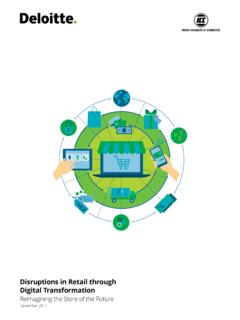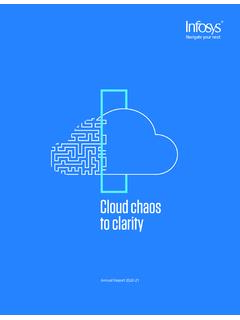Transcription of Global Trends in the Banking Industry 2020 - Infosys
1 Global Trends IN THE Banking Industry 2020 External Document 2020 Infosys Limited2 | Global Trends in the Banking Industry 2020 ContentsForeword 4 Customer experience to drive revenue 5 Trend 1: Omnichannel strategy for a 360-degree customer view 5 Trend 2: Wow the customer with digital onboarding 7 Trend 3: Open Banking for a banks all-encompassing persona 8 Focus on technology innovation 10 Trend 4: AI-driven decision making 10 Trend 5: Innovation through fintech collaboration 12 Improve cost effectiveness 14 Trend 6: Drive operational efficiencies through digitization 14 Trend 7: Manage compliance costs in an increasing regulatory environment 16 Trend 8.
2 Cloud for infrastructure resiliency and efficiency 17 References 19 Infosys contributors 20 External Document 2020 Infosys LimitedGlobal Trends in the Banking Industry 2020 | 3 External Document 2020 Infosys Limited4 | Global Trends in the Banking Industry 2020 Rajneesh MalviyaSenior Vice President,Financial Services, InfosysForewordAshok Hegde Vice President, Financial Services, InfosysMandar JoshiHead, Banking ,Financial Services, InfosysThe Banking Industry is on the cusp of adopting digitization and new-age technologies. This year (2020), digital technologies such as artificial intelligence and machine learning have enthusiastically been adopted by the Industry to address the challenges brought about by COVID-19.
3 The pandemic has forced banks to transform their decision-making processes and focus aggressively on experience remains the primary focus for banks that are looking for ways to improve it either with their applications or simplifying customer journeys and introducing omnichannel experiences. Banks will target digitization in almost all possible areas. However, COVID-19 will force banks to focus on end-to-end digitization that enable businesses to function, while wow factors such as dashboards take a back seat. Banks will increasingly rely on data to define customer journeys and drive decisions. Banks will also look to transform their back- and middle-office cost structures. And, technology adoption will be the norm this year to build resiliency in these adverse market conditions.
4 Digitization of customer onboarding and real-time regulatory checks will gain prominence as customers prefer social distancing due to the pandemic. Fintechs have become an integral part of the Banking Industry . Incumbent banks have increased their collaboration with fintechs to speed up innovation and shorten time to market. Many large banks have acquired fintechs that dovetail into their digital strategy. The Banking Industry is moving toward a more collaborative and open environment while focusing on data protection and minimizing systemic risks a tough balancing act that is no simple feat to achieve. Formulation of universal standards such as API will harmonize disparate systems that bring in interoperability of systems for commercial use.
5 In summary, banks will take aggressive steps toward building a strong base consisting of data, processes and customer experience. Digitization and advanced technologies such as AI, ML, cloud and blockchain will come to the forefront. COVID-19 has placed banks under extreme stress as revenue sources plummet and credit risks rise exponentially. Unprecedented economic disruption , a competitive market, rising customer expectations and external forces have driven the Banking Industry to explore new business models centered around digital solutions and the cloud. New business models and service offerings will be created that embrace the power of open Banking . Legacy platform transformation , adoption of technology, collaboration with fintechs and operational resiliency together will play a major role in 2020 for banks to first survive and then thrive.
6 Even though the business environment is tough, banks are taking appropriate steps to safeguard the interests of employees, shareholders and society at large. External Document 2020 Infosys LimitedGlobal Trends in the Banking Industry 2020 | 5 CUSTOMER EXPERIENCE TO DRIVE REVENUEBest-in-class customer service and frictionless experiences continue to be pivotal in Banking , and underlies many of the Trends this year. COVID-19 has exacerbated the need for digital solutions, video-based interactions and omnichannel experiences. These are necessary for banks to provide uninterrupted services, safely to customers and allow business to continue as usual. Open Banking allows banks to use customer data to create personalized products and services for customers.
7 Yet, moving away from legacy technology to adopt open- Banking systems remains a demanding 1: Omnichannel strategy for a 360-degree customer viewCustomers across industries want seamless experiences. The Banking Industry is no exception. With globalization and changing customer needs, customers want embedded digital channels in their busy lifestyles. Making customer experiences seamless would mean making the corresponding customer journeys simpler, smoother and sustained. This further implies that banks must achieve the highest levels of multichannel delivery outcomes and become truly omnichannel. Customers should not experience gaps as they move across channels. A customer should be able to start a journey in one channel, pause on it, move easily to another channel to be picked up later to complete the same journey.
8 This means banks have to work on synchronizing processes behind the scenes the customer and staff journeys must be coordinated to make them omnichannel compatible. Customers should be able to choose products or services from the location and channel of their choice with convenience and still have a consistent experience. They should be allowed to choose the most efficient and comfortable way for them to interact and still change their minds platforms help provide a 360-degree view of customers and their interactions. The centralized and synchronized orchestration of all customer interactions across multiple touch points must be device agnostic as well. digital platforms bring in omnichannel interactions and significant cost savings.
9 This can be achieved by integrating channels, products, processes, peripheral applications, and underlying data and infrastructures, while decreasing the dependence on the core Banking systems. These platforms allow banks to deliver seamless end-to-end digital Banking experiences and are scalable and enable banks to capture a 360-degree view of customer behavior across multiple Document 2020 Infosys Limited6 | Global Trends in the Banking Industry 2020As a next step, banks need to think first about all the possible interactions the customer might want to have before thinking about the channels, processes, devices, technology and applications. This will shift the bank s focus from being inward-centric to being customer-centric.
10 Focusing on the customer can also help banks identify and collaborate with third-party providers and fintechs in order to provide a better customer experience. For example, Bank Millennium in Poland has implemented mass personalization based on customer behavior segmentation. As a result, the bank was able to sell half of its retail loans through its digital can then use data and artificial intelligence in order to understand and predict customer behavior. Royal Bank of Canada has implemented an AI platform that provides easier, faster, more accessible and proactive services to its customers in managing branch numbers are shrinking globally, they will not go extinct. While the load of the branch will be redistributed, branches will continue to be pivotal to the omnichannel strategy and the digital Banking platform, as customers will use them as the last bastion for unresolved queries.














